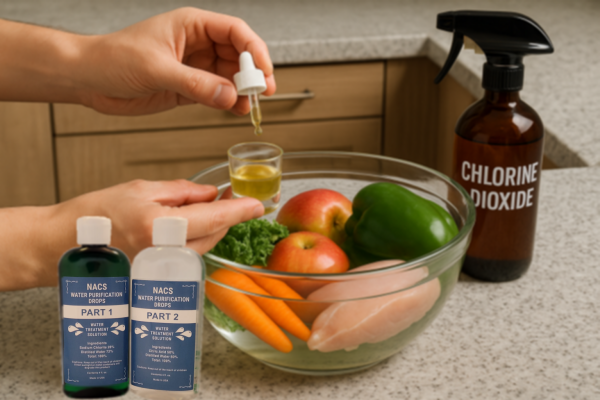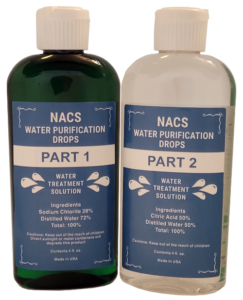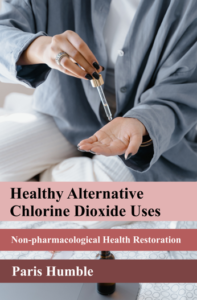Every day, food makes its way into your kitchen from farms, factories, and supermarkets. But did you know that even after all the industrial cleaning and packaging, dangerous pathogens can still hide deep inside the food you bring home? It’s true, and while food processors and supermarkets use chlorine dioxide to disinfect food and surfaces, these are mostly surface treatments.
Pathogens like bacteria, viruses, mold, parasites, and toxins can still permeate deeper into meats, fruits, and vegetables. That’s why more and more home cooks are taking food safety into their own hands by presoaking their food in chlorine dioxide right at home.
Let’s explore why this matters, how it works, and how you can do it safely and effectively in your own kitchen.
🦠 Why Use Chlorine Dioxide at Home?
The same chlorine dioxide used in food processing plants, water treatment facilities, and hospital sanitization is now being used by health-conscious households to keep food safe.
Here’s why:
- Kills a broad range of pathogens – including bacteria like E. coli and Salmonella, viruses, mold spores, and even parasites.
- Penetrates deeper than simple rinsing – reducing risk of foodborne illness.
- No harmful residue – after working its magic, chlorine dioxide breaks down into a harmless, bioavailable salt (like saline), unlike chlorine which can leave chemical residues.
- Extends freshness – by killing spoilage organisms, food stays fresh longer.
Supermarkets spray chlorine dioxide on fruits, veggies, and meats—but these are quick, light applications. By pre-soaking at home, you add an extra layer of protection for your family’s health.
How to Sanitize Food at Home with Chlorine Dioxide
Food Pre-Soak Instructions
- Prepare your soaking bowl:
- Fill a large clean bowl with enough water to fully cover your food.
- Use distilled or filtered water if available, especially if your tap water has contaminants.
- Activate the chlorine dioxide:
- In a clean dry glass (like a shot glass), mix:
- 10 to 15 drops of Part 1 (Sodium Chlorite Solution)
- 10 to 15 drops of Part 2 (Citric Acid Activator)
- Swirl the drops together and let them activate for 30 seconds.
- In a clean dry glass (like a shot glass), mix:
- Add the activated chlorine dioxide to the bowl of water and stir gently.
- You now have a powerful food sanitizer ready to use!
- Place food into the solution and soak for:
- 5 to 10 minutes for meats (chicken, beef, fish, etc.)
- 3 to 5 minutes for leafy greens and vegetables
- 2 to 3 minutes for fruits
- Remove food and allow it to air dry.
- Do not rinse again with tap water (unless using purified water). Rinsing with untreated water may reintroduce contaminants.
- Remember: chlorine dioxide breaks down into a mild, safe salt residue, so no harmful chemicals are left behind.
Sanitizing Kitchen Surfaces with Chlorine Dioxide Spray
Food safety doesn’t stop at washing food—the surfaces you prepare it on also matter.
You can make a simple kitchen sanitizing spray:
- In a clean glass, activate 10 to 15 drops of Part 1 with 10 to 15 drops of Part 2 (just like above).
- After 30 seconds, pour the activated solution into a spray bottle filled with water.
- Use this spray on:
- Countertops
- Cutting boards
- Sink areas
- Sponges and dish cloths
Let surfaces air dry after spraying, or wipe with a clean towel.
💡 Fun fact: Industrial food processors sanitize surfaces with chlorine dioxide sprays or gas fumigation for exactly the same reasons—it’s highly effective without harmful residues.
🥬 What Foods Should You Pre-Treat?
You can safely sanitize virtually all types of food with a chlorine dioxide soak:
| Food Type | Recommended Soak Time | Why It Matters |
| Meats (chicken, beef) | 5–10 minutes | Reduces bacteria like E. coli, Salmonella |
| Fish and seafood | 5–10 minutes | Prevents seafood-borne illness |
| Leafy greens (spinach) | 3–5 minutes | Removes bacteria and parasites hiding in folds |
| Root veggies (potatoes) | 3–5 minutes | Cleans soil pathogens, pesticide residues |
| Fruits (apples, berries) | 2–3 minutes | Removes bacteria, mold spores, pesticide film |
✅ Special note for delicate foods (like berries): soak a little shorter and handle gently to avoid bruising.
Why Traditional Washing Isn’t Enough
Many people think rinsing food under tap water is sufficient. Unfortunately:
- Tap water doesn’t kill pathogens—it may even introduce new ones from old pipes.
- Chlorine-based veggie washes can leave chemical residues and may not kill hardier microbes.
- Some pathogens are resistant to chlorine or hide in crevices, folds, and microscopic pores.
Chlorine dioxide solves these problems by oxidizing pathogens on contact, penetrating deeper, and leaving no harmful residue.
Take Control of Your Food Safety
Every day, food passes through countless hands, machines, and environments before it reaches your kitchen. Even though processing plants and supermarkets use chlorine dioxide to protect you, those treatments don’t always eliminate everything.
By taking simple, proactive steps to sanitize your food at home with chlorine dioxide, you’re giving your family an added layer of protection from unseen threats—and peace of mind that your meals are safe.
In a world of unpredictable contamination risks, chlorine dioxide is one of the most powerful, safe, and effective tools you can have in your kitchen.
- Safer food
- Fewer pathogens
- Extended freshness
- Cleaner kitchen
Why leave food safety up to chance—when you can take control at home?




